-

新人教版高中英语选修2Unit 1 Science and Scientists-Discovering useful structures教学设计
The grammatical structure of this unit is predicative clause. Like object clause and subject clause, predicative clause is one of Nominal Clauses. The leading words of predicative clauses are that, what, how, what, where, as if, because, etc.The design of teaching activities aims to guide students to perceive the structural features of predicative clauses and think about their ideographic functions. Beyond that, students should be guided to use this grammar in the context apporpriately and flexibly.1. Enable the Ss to master the usage of the predicative clauses in this unit.2. Enable the Ss to use the predicative patterns flexibly.3. Train the Ss to apply some skills by doing the relevant exercises.1.Guide students to perceive the structural features of predicative clauses and think about their ideographic functions.2.Strengthen students' ability of using predicative clauses in context, but also cultivate their ability of text analysis and logical reasoning competence.Step1: Underline all the examples in the reading passage, where noun clauses are used as the predicative. Then state their meaning and functions.1) One theory was that bad air caused the disease.2) Another theory was that cholera was caused by an infection from germs in food or water.3) The truth was that the water from the Broad Street had been infected by waste.Sum up the rules of grammar:1. 以上黑体部分在句中作表语。2. 句1、2、3中的that在从句中不作成分,只起连接作用。 Step2: Review the basic components of predicative clauses1.Definition

新人教版高中英语选修2Unit 4 Journey Across a Vast Land教学设计
当孩子们由父母陪同时,他们才被允许进入这个运动场。3.过去分词(短语)作状语时的几种特殊情况(1)过去分词(短语)在句中作时间、条件、原因、让步状语时,相当于对应的时间、条件、原因及让步状语从句。Seen from the top of the mountain (=When it is seen from the top of the mountain), the whole town looks more beautiful.从山顶上看,整个城市看起来更美了。Given ten more minutes (=If we are given ten more minutes), we will finish the work perfectly.如果多给十分钟,我们会完美地完成这项工作。Greatly touched by his words (=Because she was greatly touched by his words), she was full of tears.由于被他的话深深地感动,她满眼泪花。Warned of the storm (=Though they were warned of the storm), the farmers were still working on the farm.尽管被警告了风暴的到来,但农民们仍在农场干活。(2)过去分词(短语)在句中作伴随、方式等状语时,可改为句子的并列谓语或改为并列分句。The teacher came into the room, followed by two students (=and was followed by two students).后面跟着两个学生,老师走进了房间。He spent the whole afternoon, accompanied by his mom(=and was accompanied by his mom).他由母亲陪着度过了一整个下午。

新人教版高中英语选修2Unit 1 Science and Scientists-Learning about Language教学设计
Step 7: complete the discourse according to the grammar rules.Cholera used to be one of the most 1.__________ (fear) diseases in the world. In the early 19th century, _2_________ an outbreak of cholera hit Europe, millions of people died. But neither its cause, 3__________ its cure was understood. A British doctor, John Snow, wanted to solve the problem and he knew that cholera would not be controlled _4_________ its cause was found. In general, there were two contradictory theories 5 __________ explained how cholera spread. The first suggested that bad air caused the disease. The second was that cholera was caused by an _6_________(infect) from germs in food or water. John Snow thought that the second theory was correct but he needed proof. So when another outbreak of cholera hit London in 1854, he began to investigate. Later, with all the evidence he _7_________ (gather), John Snow was able to announce that the pump water carried cholera germs. Therefore, he had the handle of the pump _8_________ (remove) so that it couldn't be used. Through his intervention,the disease was stopped in its tracks. What is more, John Snow found that some companies sold water from the River Thames that __9__________________ (pollute) by raw waste. The people who drank this water were much more likely _10_________ (get) cholera than those who drank pure or boiled water. Through John Snow's efforts, the _11_________ (threaten) of cholera around the world saw a substantial increase. Keys: 1.feared 2.when 3. nor 4.unless 5.that/which 6.infection 7.had gathered 8.removed 9.was polluted 10.to get 11. threat

新人教版高中英语选修2Unit 1 Science and Scientists-Reading and thinking教学设计
Step 5: After learning the text, discuss with your peers about the following questions:1.John Snow believed Idea 2 was right. How did he finally prove it?2. Do you think John Snow would have solved this problem without the map?3. Cholera is a 19th century disease. What disease do you think is similar to cholera today?SARS and Covid-19 because they are both deadly and fatally infectious, have an unknown cause and need serious public health care to solve them urgently.keys:1. John Snow finally proved his idea because he found an outbreak that was clearly related to cholera, collected information and was able to tie cases outside the area to the polluted water.2. No. The map helped John Snow organize his ideas. He was able to identify those households that had had many deaths and check their water-drinking habits. He identified those houses that had had no deaths and surveyed their drinking habits. The evidence clearly pointed to the polluted water being the cause.3. SARS and Covid-19 because they are both deadly and fatally infectious, have an unknown cause and need serious public health care to solve them urgently.Step 6: Consolidate what you have learned by filling in the blanks:John Snow was a well-known _1___ in London in the _2__ century. He wanted to find the _3_____ of cholera in order to help people ___4_____ it. In 1854 when a cholera __5__ London, he began to gather information. He ___6__ on a map ___7___ all the dead people had lived and he found that many people who had ___8____ (drink) the dirty water from the __9____ died. So he decided that the polluted water ___10____ cholera. He suggested that the ___11__ of all water supplies should be _12______ and new methods of dealing with ____13___ water be found. Finally, “King Cholera” was __14_____.Keys: 1. doctor 2. 19th 3.cause 4.infected with 5.hit 6.marked 7.where 8.drunk 9.pump 10.carried 11.source 12.examined 13.polluted 14.defeatedHomework: Retell the text after class and preview its language points

新人教版高中英语选修2Unit 1 Science and Scientists-Using langauge教学设计
This happens because the dish soap molecules have a strong negative charge, and the milk molecules have a strong positive charge. Like magnets, these molecules are attracted to each other, and so they appear to move around on the plate, taking the food coloring with them, making it look like the colors are quickly moving to escape from the soap.Listening text:? Judy: Oh, I'm so sorry that you were ill and couldn't come with us on our field trip. How are you feeling now? Better?? Bill: Much better, thanks. But how was it?? Judy: Wonderful! I especially liked an area of the museum called Light Games.it was really cool. They had a hall of mirrors where I could see myself reflected thousands of times!? Bill: A hall of mirrors can be a lot of fun. What else did they have?? Judy: Well, they had an experiment where we looked at a blue screen for a while, and then suddenly we could see tiny bright lights moving around on it. You'll never guess what those bright lights were!? Bill: Come on, tell me!? Judy: They were our own blood cells. For some reason, our eyes play tricks on us when we look at a blue screen, and we can see our own blood cells moving around like little lights! But there was another thing I liked better. I stood in front of a white light, and it cast different shadows of me in every color of the rainbow!? Bill: Oh, I wish I had been there. Tell me more!? Judy: Well, they had another area for sound. They had a giant piano keyboard that you could use your feet to play. But then, instead of playing the sounds of a piano, it played the voices of classical singers! Then they had a giant dish, and when you spoke into it, it reflected the sound back and made it louder. You could use it to speak in a whisper to someone 17 meters away.? Bill: It all sounds so cool. I wish I could have gone with you? Judy: I know, but we can go together this weekend. I'd love to go there again!? Bill: That sounds like a great idea!

新人教版高中英语选修2Unit 2 Bridging Cultures-Discovering useful structures教学设计
The grammar of this unit is designed to review noun clauses. Sentences that use nouns in a sentence are called noun clauses. Nominal clauses can act as subject, object, predicate, appositive and other components in compound sentences. According to the above-mentioned different grammatical functions, nominal clauses are divided into subject clause, object clause, predicate clause and appositive clause. In this unit, we will review the three kinds of nominal clauses. Appositive clauses are not required to be mastered in the optional compulsory stage, so they are not involved.1. Guide the students to judge the compound sentences and determine the composition of the clauses in the sentence.2. Instruct students to try to learn grammar by generalizing grammar rules, controlling written practice, and semi-open oral output.3. Inspire the students to systematize the function and usage of noun clause1.Instruct students to try to learn grammar by generalizing grammar rules, controlling written practice, and semi-open oral output.2.Inspire the students to systematize the function and usage of noun clauseStep1: The teacher ask studetns to find out more nominal clauses from the reading passage and udnerline the nominal clauses.

新人教版高中英语选修2Unit 3 Food and Culture-Reading and thinking教学设计
The discourse explores the link between food and culture from a foreign’s perspective and it records some authentic Chinese food and illustrates the cultural meaning, gerography features and historic tradition that the food reflects. It is aimed to lead students to understand and think about the connection between food and culture. While teaching, the teacher should instruct students to find out the writing order and the writer’s experieces and feelings towards Chinese food and culture.1.Guide the students to read the text, sort out the information and dig out the topic.2.Understand the cultural connotation, regional characteristics and historical tradition of Chinese cuisine3.Understand and explore the relationship between food and people's personality4.Guide the students to use the cohesive words in the text5.Lead students to accurately grasp the real meaning of the information and improve the overall understanding ability by understanding the implied meaning behind the text.1. Enable the Ss to understand the structure and the writing style of the passage well.2. Lead the Ss to understand and think further about the connection between food and geography and local character traits.Step1: Prediction before reading. Before you read, look at the title, and the picture. What do you think this article is about?keys:It is about various culture and cuisine about a place or some countries.

新人教版高中英语选修2Unit 5 First Aid-Discovering useful structures教学设计
You have no excuse for not going.你没有理由不去。He was punished for not having finished his homework.他因未完成作业而受到惩罚。2.动词ing形式复合结构由物主代词或人称代词宾格、名词所有格或普通格加动词ing,即“sb./sb.'s+doing”构成。动词ing形式的复合结构实际上是给动词ing形式加了一个逻辑主语。动词ing形式的复合结构有四种形式:①形容词性物主代词+动词ing②名词所有格+动词ing③代词宾格+动词ing④名词+动词ingHer coming to help encouraged all of us.她来帮忙鼓舞了我们所有人。The baby was made awake by the door suddenly shutting.这个婴儿被突然的关门声吵醒了。Can you imagine him/Jack cooking at home?你能想象他/杰克在家做饭的样子吗?无生命名词无论是作主语还是作宾语都不能用第②种形式。Tom's winning first prize last year impressed me a lot.汤姆去年得了一等奖使我印象深刻。Do you mind my/me/Jack's/Jack leaving now?你介意我/杰克现在离开吗?Excuse me for my not coming on time.很抱歉我没能按时来。His father's being ill made him worried.他父亲病了,他很担心。We are looking forward to the singer's/the singer to give us a concert.我们盼望着这位歌手来给我们举办一场演唱会。

人教版高中历史必修3西方人文主义思想的起源说课稿
苏格拉底把装有毒酒的杯子举到胸口,平静地说:“分手的时候到了,我将死,你们活下来,是谁的选择好,只有天知道。”说毕,一口喝干了毒酒。(2) 苏格拉底临死前对一个叫克力同的人说了这样一番话。克力同,我告诉你,这几天一直有一个神的声音在我心中晓喻我,他说:“苏格拉底,还是听我们的建议吧,我们是你的卫士。不要考虑你的子女、生命或其他东西胜过考虑什么是公正。……事实上你就要离开这里了。当你去死的时候,你是个牺牲品,但不是我们所犯错误的牺牲品,而是你同胞所犯错误的牺牲品。但你若用这种可耻的方法逃避,以错还错,以恶报恶,践踏你自己和我们订立的协议合约,那么你伤害了你最不应该伤害的,包括你自己、你的朋友、你的国家,还有我们。到那时,你活着面对我们的愤怒,你死后我们的兄弟、冥府里的法律也不会热情欢迎你;因为它们知道你试图尽力摧毁我们。别接受克力同的建议,听我们的劝告吧。”
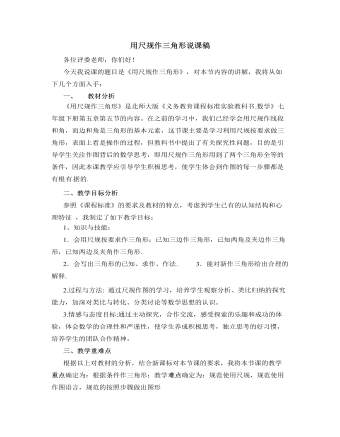
北师大版初中七年级数学下册用尺规作三角形说课稿
《用尺规作三角形》是北师大版《义务教育课程标准实验教科书.数学》七年级下册第五章第五节的内容。在之前的学习中,我们已经学会用尺规作线段和角,而边和角是三角形的基本元素,这节课主要是学习利用尺规按要求做三角形,表面上看是操作的过程,但教科书中提出了有关探究性问题,目的是引导学生关注作图背后的数学思考,即用尺规作三角形用到了两个三角形全等的条件,因此本课教学应引导学生积极思考,使学生体会到作图的每一步骤都是有根 有 据的.二、教学目标分析参照《课程标准》的要求及教材的特点,考虑到学生已有的认知结构和心理特征 ,我制定了如下教学目标:1、知识与技能:1.会用尺规按要求作三角形:已知三边作三角形,已知两角及夹边作三角形,已知两边及夹角作三角形.2.会写出三角形的已知、求作、作法. 3.能对新作三角形给出合理的解释.
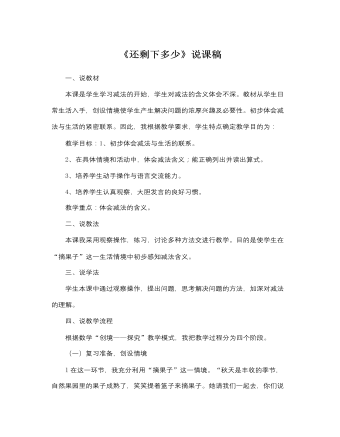
北师大版小学数学一年级上册《还剩下多少》说课稿
教学目标:1、初步体会减法与生活的联系。2、在具体情境和活动中,体会减法含义;能正确列出并读出算式。3、培养学生动手操作与语言交流能力。4、培养学生认真观察,大胆发言的良好习惯。教学重点:体会减法的含义。二、说教法本课我采用观察操作,练习,讨论多种方法交进行教学。目的是使学生在“摘果子”这一生活情境中初步感知减法含义。三、说学法学生本课中通过观察操作,提出问题,思考解决问题的方法,加深对减法的理解。四、说教学流程根据数学“创境——探究”教学模式,我把教学过程分为四个阶段。(一)复习准备,创设情境l在这一环节,我充分利用“摘果子”这一情境。“秋天是丰收的季节,自然果园里的果子成熟了,笑笑提着篮子来摘果子。她请我们一起去,你们说好吗?那我们出发吧!这样学生的好奇心一下子被调动起来渡到第二阶段。

北师大版小学数学五年级上册《人民币兑换》说课稿
2、利用已有知识,引导学生自主探索求积、商近似值的方法。在学生想出6.7美元折成人民币时要用乘法计算时,引导学生独立计算得出结果后发现问题并尝试独立解决。使学生认识到积的近似值可以用四舍五入的方法求近似值。接着出示第二个情境“妈妈用600元人民币到银行可兑换多少美元?”由学生独立完成,在学生交流的基础上进一步总结求积、商的近似值的方法:积取近似值是先精确计算,在根据题目的要求取近似值;商取近似值是直接根据要求多除一位,然后取近似值。3、巩固练习在学生初步掌握求积、商的近似值的方法后,我安排了教材67页的试一试,让学生体会如何按要求取近似值;教材68页的练一练,涉及到了多个国家的货币与人民币的兑换使学生进一步感受到数学与日常生活的密切联系

人音版小学音乐二年级上册快乐的音乐会说课稿
新课标中鼓励音乐创造,注重个性发展,教师应为学生提供发展个性的可能和空间。在这一环节中我以这样一句话:“嘘,别出声,我好像听到谁在叫我,引出小鸡,小鸭加入到我们都行列中来”导入。现在,能不能像老师一样,把这些小动物的声音编成歌词,创作出一首新的主题曲?谁来试试?”学生创编好歌词说:“小朋友们让我们,随着欢快的音乐唱起来、跳起来吧!”来举办一场快乐的音乐会。五、说板书根据本课的教学目标和教学重难点我的板书是这样设计的。板书课题引起学生注意,让学生知道本节课的教学内容;板书难点是为了达到突破难点的目的。六、说反思本课我以“快乐”为主线,贯穿全课。在课堂上体现了以教师为主导,学生为主线的教学理念,实现了合作探究式的学习方法。回顾整个教学环节,在拓展创编这一环节中,由于时间有限,我把学生局限于我预设的几种动物和乐器上,对学生的想象力有些限制。今后,我将力所能及的做到符合学生实际来设计教学。
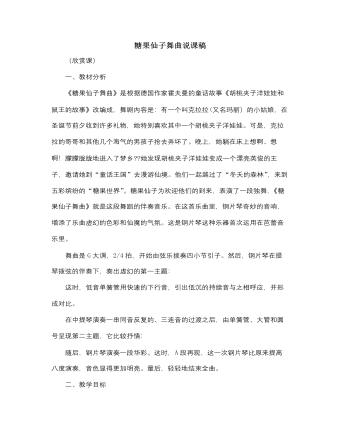
人音版小学音乐二年级上册糖果仙子舞曲说课稿
在中提琴演奏一串同音反复的、三连音的过渡之后,由单簧管、大管和圆号呈现第二主题,它比较抒情:随后,钢片琴演奏一段华彩。这时,A段再现,这一次钢片琴比原来提高八度演奏,音色显得更加明亮。最后,轻轻地结束全曲。二、教学目标初步了解芭蕾舞剧,感受《糖果仙子舞曲》优美的情绪。三、教学重难点教学重点对乐曲进行体验实践,听辨乐曲的情绪。教学难点听辨不同乐器的音色特点。四、教学过程(一)导入播放《糖果仙子舞曲》,学生听辨音乐的情绪(优美动听)(二)感受乐曲导语:《糖果仙子舞曲》是舞剧《胡桃夹子》中糖果仙子一个人的独舞,我们来了解一下《糖果仙子舞曲》的故事。1.芭蕾舞剧《胡桃夹子》简介教师结合图片,简单讲述童话故事《胡桃夹子》以及芭蕾舞剧的特点。2.再次欣赏乐曲《糖果仙子舞曲》,引导学生想象音乐表现的情景。 随音乐,再次聆听,感受乐曲中乐器的音色特点。
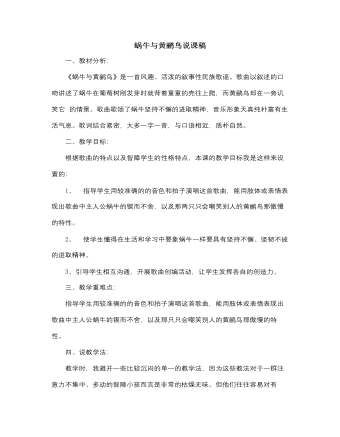
人音版小学音乐二年级上册蜗牛与黄鹂鸟说课稿
a.模仿老师一句一句地,有节奏地读歌词,注意老师手上的木鱼敲打的节奏。b.和老师一起把歌词读一遍,注意强调切分节奏的读法。c.学习歌曲:第一遍,老师一句一句地教学生唱,同时用电子琴弹出旋律。第二遍,老师一边一句一句地教唱,一边做出舞蹈动作,学生在下面模仿。d.学生听老师的电子琴伴奏,齐唱歌曲。2.歌曲演唱:演唱a.“有请我们班的小歌星子喻同学为我们演唱好不好?”b.“我们来组个乐团,怎么样?” c. “那我们的乐团起什么名字好呢?”“叽叽喳喳合唱团。”d. “现在老师宣布,我们的叽叽喳喳合唱团正式开演!”小结:“今天老师很高兴和同学们一起学习《蜗牛与黄鹂鸟》这首歌曲,老师看到了同学们的精彩表演,心里非常感动。在这里,老师希望同学们今后要像蜗牛一样,在学习上或者是生活上,不管遇到什么困难都勇敢面对,克服困难,坚持到底!同学们加油!
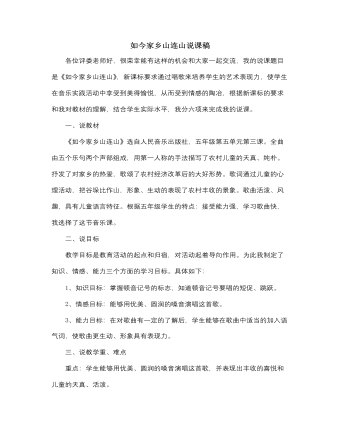
人音版小学音乐三年级上册如今家乡山连山说课稿
3、拓展要求:在学生对歌曲有了一定的了解之后,我会让学生在歌词中适当的地方加入语气词,使歌曲更生动、形象。例如:“妈妈告诉我,家乡没有山”这句歌词,显得有点惋惜和遗憾之情,我觉得用“唉”比较好,下面的就分组讨论。每小组派一个代表唱出自己组里填的语气词。在所有组里的语气词里选一组最好的,确定下来。全班一起演唱,并加上确定的语气词。唱歌比赛:将学生分4个组,一组高声部、一组低声部、一组加语气词、一组加打击乐器(如沙锤、双响筒、碰玲),增强他们的合作意识和合作默契。4、小结在课堂小结时我先安排了学生谈一谈这节课的感想,如:这节课你学到了什么?歌曲中你最喜欢那一句?而且对那些有创意的学生我还及时的发给他们小奖品。在本课的教学中我以表扬和鼓励为主,随时引导学生在音乐活动中开展自评互评和老师的随堂评价,以提高学生的乐感和审美能力。
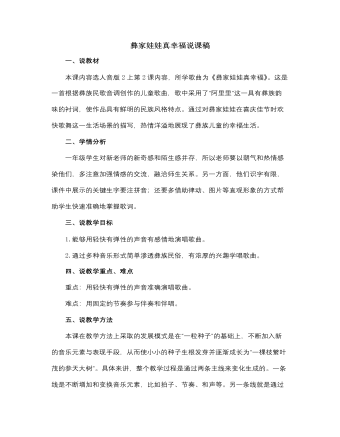
人音版小学音乐二年级上册彝家娃娃真幸福说课稿
环节四:拓展延伸感悟彝乐这是对所学内容进行反馈、提高的过程。学生利用在课中收集到的信息选出一首彝族民歌来,然后在一曲《远方的客人请你留下来》中跟彝家娃娃说再见。本课亮点:一、轻快活泼的声音和准确的学唱始终是同时进行并完成的,即唱好歌是在唱会歌中体现的,歌曲的处理和表达是在学习歌曲的过程中完成的,会唱歌是在唱好歌中生成的,三者融为一体,同时达成目标。二、根据歌曲演唱和情绪调动的不同视听需要,将综合了的人文信息点状散发,极具艺术性地分插到每个环节中,恰当地处理了音乐和人文的关系。三、在整节课浓郁的情境体验中,学生似乎真正进入了彝家山寨,和彝家娃娃一起学唱歌、学说彝语、学跳舞并且欢度了一个开心的火把节。
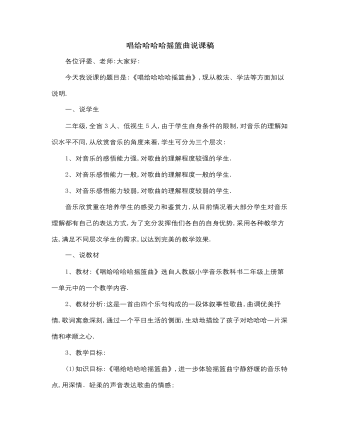
人音版小学音乐三年级上册唱给哈哈哈摇篮曲说课稿
(4)演一演视障生由于生理缺陷,在他们的头脑中很难形成动作形体概念,用情景教学法,使学生身临其境,要求他们不一定按歌曲要求的动作表现,只需要他们把那种对音乐的理解用自己的方式表现出来,边听音乐边表演.通过这样的训练,提高学生的肢体语言能力,同时能大胆发挥想象,做自己对音乐理解的动作,通过动作使其更深刻的理解歌曲.对于低视生让他们通过看课件及对歌曲的理解,创遍简单的舞蹈动作,使其与歌曲的情节相融合,更深刻的体味歌曲内涵.(5)复听歌曲一遍让学生仔细的听乐曲,感受乐曲所带给的独特感受,让他们融入到乐曲中,展开想象,发展他们的空间想象力和创造力,同时提高他们的鉴赏水平.六、课堂小结感谢从小养育我们的父母;感谢一直关心着我们的父母;感谢为我们而操劳的父母……要感谢的太多太多了,就让我们怀着一颗感恩的心,报答我们的父母吧!
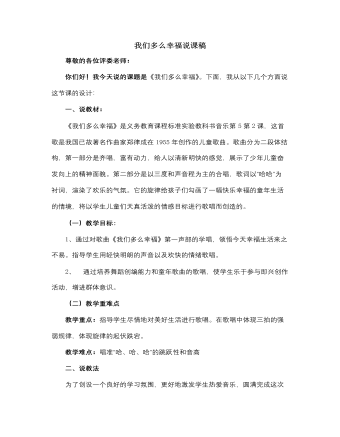
人音版小学音乐三年级上册我们多么幸福说课稿
教师有感情的教唱歌曲,学生感受歌曲的情绪、节奏、节拍的同时跟着学唱。在这基础上学唱歌词,随琴听唱,要求注意 3/4 拍的强弱规律, 请同学们打拍子随老师一起唱,再组织同学们积极参与课堂活动,教师给予评价。(3)随歌起舞美的旋律、美的歌词更需要美的舞姿。为了激发音乐学习兴趣,我在本歌曲完全好以后,让学生们用舞蹈来表现歌曲,组织学生通过自主合作、互相启迪、探讨来再现歌曲并进行歌舞创编。教师给予启发和指导舞蹈动作,强化老师参与者和合作者的身份,体现师生融洽关系。(三)总结同学们这节课开心吗?这样的学习生活幸福吗?那我们要珍惜这份幸福,让我们再次唱响幸福,为幸福喝彩。(播放歌曲,让学生听着或唱着,带着愉快的心情去享受课间活动的快乐。)
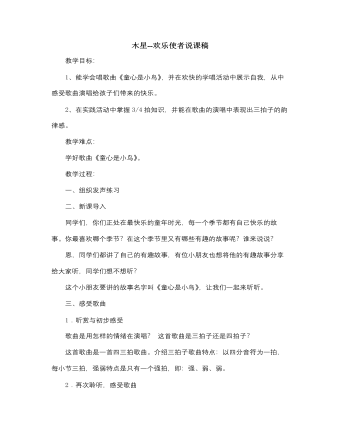
人音版小学音乐六年级上册木星-欢乐使者说课稿
(1)在聆听时注意跟着细声的哼唱,再次感受歌曲的情绪,感受四三拍的特点。(2)注意观察歌词,看看歌曲描写的是哪些季节。这些呢都是这个小朋友的快乐童年,小朋友说他想将他的快乐童年分享给我们,同学们愿意接受吗?四、学习歌曲 1、好,让我们一起来分享这个朋友的快乐童年,请同学们跟老师有感情的朗诵歌词。(边打拍子,边读歌词)同学们,通过刚刚的聆听和现在对歌词的朗读,你认为歌曲可分为几部分?歌曲可以分为两部分,第一部分、第二部分。2、跟琴学唱歌曲。第一部分要表达出喜悦、自豪的心情,声音要轻盈有弹性;第二部分歌词注意欢快的情绪,声音要舒展、连贯。3、完整演唱乐曲。五、课堂小结最后,让我们随着优美的音乐,为我们的童心插上小鸟的翅膀,一起唱起来,跳起来,飞进大自然的怀抱中。

